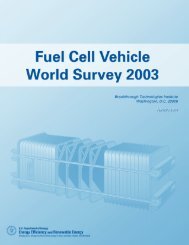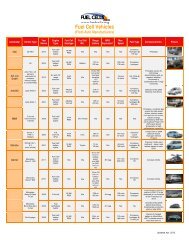Breakthrough Technologies Institute - Fuel Cells 2000
Breakthrough Technologies Institute - Fuel Cells 2000
Breakthrough Technologies Institute - Fuel Cells 2000
Create successful ePaper yourself
Turn your PDF publications into a flip-book with our unique Google optimized e-Paper software.
Harkins House juvenile shelter, Hillsboro: A natural gas-powered Plug Power PEM<br />
fuel cell was installed in 2003 to generate electric power and heat for hot water. The<br />
installation was a project of the Combined Heat and Power consortium.<br />
Columbia Boulevard Wastewater Treatment Plant, Portland: Under Portland’s<br />
Energy Challenge program, the City's Bureau of Environmental Services operated a<br />
UTC Power 200-kW methane-powered fuel cell at the Columbia Boulevard Wastewater<br />
Treatment Plant. The fuel cell provided power between 1999 and 2005 and saved the<br />
city about $58,000/year. Funding for this project included a $200,000 grant from DoD<br />
and a $224,000 tax credit from the Oregon Office of Energy.<br />
LIFT facility at Powell Garage, Portland: A ReliOn 1-kW PEM fuel cell provides back<br />
up power to keep sensitive equipment running during power outages, replacing an<br />
oversized diesel generator that burns up to 10 gallons of fuel per hour. The project was<br />
sponsored by the Bonneville Power Administration and Tri-County Metropolitan<br />
Transportation District (TRIMET).<br />
2. STANDARDS/REGULATIONS<br />
POWER GENERATION<br />
PENNSYLVANIA<br />
Alternative Energy Portfolio Standard<br />
www.puc.state.pa.us/electric/electric_alt_energy_port_stnds.aspx<br />
The Alternative Energy Portfolio Standards Act was signed into law in 2004 and took<br />
effect in February 2005. The Act requires that a certain percentage of the electric<br />
energy sold to retail customers in Pennsylvania by electric distribution companies<br />
(EDCs) and electric generation suppliers (EGSs) be derived from alternative energy<br />
resources. This includes Tier 1 resources (solar photovoltaic energy, solar thermal<br />
energy, wind, low-impact hydro, geothermal, biomass, biologically derived methane gas,<br />
coal mine methane and fuel cells) and Tier II resources (waste coal, distributed<br />
generation systems, demand-side management, large-scale hydro, municipal solid<br />
waste, pulping process and wood manufacturing byproducts and integrated combined<br />
coal gasification technology).<br />
EDCs and EGSs must provide retail electric customers electric energy derived from Tier<br />
I resources no later than February 28, 2007. While the Act does not specifically identify a<br />
start date for Tier II compliance, the PUC has decided that Tier II compliance will also<br />
commence on February 28, 2007. The percentage of energy derived from alternative<br />
sources will increase yearly until 2020:<br />
• Tier I resources (except solar photovoltaic), which will start at 1.5% of retail<br />
energy sales by no later than the end of February 2007, will increase by 0.5%<br />
176






